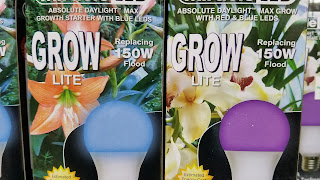Growing herbs indoors is a great way to continue gardening right through the coldest days of the season. By growing your own culinary herbs indoors, you will be rewarded with fresh cooking herbs you grow and harvest yourself, as well as the color and aroma herbs bring to the table. Here are some tips to help you grow healthy herbs indoors successfully. While temperature and humidity are important, the key factor to growing herbs indoors is light. Herbs growing indoors need at least six hours of sunlight in order to thrive. You can grow a wide variety of herbs indoors anywhere they will get at least six hours of sunlight, such as a south or west facing window.
Your other option is to supplement your natural lighting with additional lighting from a fluorescent fixture, CFL or an incandescent bulb. Grow bulbs are available which will fit a standard socket such as a desk lamp. This makes it easier to achieve the light you need to grow the herbs indoors successfully. Placing your herb plants in the kitchen or bathroom under grow lights helps ensure they will stay warm and humid naturally. Providing the right amount of sunlight and the correct ambient temperature encourages the strong, healthy growth of your herb plants and the best tasting foliage.
Start with quality herb plants. You can grow herbs from seed, but it takes time for them to reach the point when you can begin to harvest from them. Popular herbs which do well inside are cilantro, oregano, parsley, basil, sage, rosemary and thyme, but most herbs lend themselves very well to be grown in pots and containers indoors, if there is sufficient light.
You have many options when it comes to selecting a container for your herb plants. The main consideration is to choose a pot that’s the correct size for the plants you are growing and that it drains. If you tend to over water your plants, choose containers made from clay. Clay is porous. It breathes and pulls moisture away from roots. Choosing pots that are the right size for your plants is important because over-potting will lead to root problems. Another option is to combine herbs into a single container. There are many attractive clay or ceramic container options to plant herbs in, just be sure the container has good drainage.
Along with the right sized pot, select a potting soil that drains well. The Flower Bin Potting Soil Mix is a good choice. Happy Frog Potting soil also works well. Both contain mycorrhizae for better root development. Plan to feed your herbs every two weeks with a well-balanced fertilizer such as a granular 4-4-4 or water-soluble 6-4-4. If you prefer organic, the Organic Material Review Institute – OMRI logo on the package assures you the fertilizer is indeed certified organic.
Apart from cooking, herbs make great house plants. Pineapple Sage for example, has a pleasant fragrance and will flower, plus many herbs have a relaxing aroma, even when they are not blooming. An indoor herb garden allows you to enjoy the flavor, fragrance and assurance of quality cooking ingredients year-round.






No comments:
Post a Comment